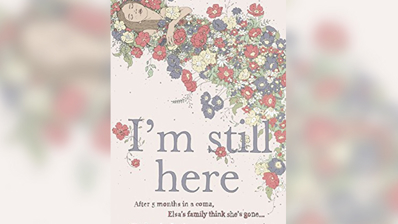Stephanie Jones: Book Review - I'm Still Here
- Publish date
- Wednesday, 27 Jul 2016, 4:14PM

Imagine: you’ve been in a coma for 20 weeks and for the past six you’ve known it, because your hearing spontaneously returned. It came unaccompanied, though, so you are unable to response to touch or sound, and neither your devoted friends, who visit you often, nor the able but mostly dispassionate doctors who attend you can detect your awareness. The statistics are not in your favour, and based on a near-zero chance of recovery, the doctors are advising your family to switch off the machines keeping you alive. And, by the way, you’ve fallen in love with a stranger.
If the premise of Clelie Avit’s I’m Still Here sounds preposterous, manipulative, even glib, give it a chance, for what the writer, whose novel is translated from the French by Lucy Foster, is capable of wrangling from a love story with one-sided conversation is remarkable. She shifts between the perspectives of Elsa, comatose after a climbing accident, and Thibault, who visits her ward when his brother is hospitalized after a drink-driving accident that killed two teenagers. Thibault is a man with issues, as they say: he is repulsed by his brother’s wrongdoing and horrified by their mother’s blind devotion, and shattered by the recent end of a bad relationship. Visiting friends with a young child, he feels envious of their peaceable family life.
On encountering Elsa lying silent and alone, Thibault finds respite in her room, and returns again and again to talk to her. In the absence of other sensory capacity her hearing has become razor-sharp, and she can decipher the moods of her visitors by how they breathe and move, and by the words left unspoken between them. Thibault and a young house doctor are the only people paying close enough attention to detect Elsa’s renewed consciousness.
In a novel of a different type, Thibault’s behaviour towards Elsa would be downright worrying, not to mention legally actionable. On several visits, he strips off his outer layers of clothing and moves Elsa, detaching and reattaching various tubes, so he can lie down next to her in the bed, pressing his body firmly against hers. Quentin Tarantino had a sinister take on the comatose woman / male attendant scenario in the first edition of Kill Bill, but Avit’s is wholesome. Hanky-panky occurs only in a brief visit to Thibault’s apartment by his vile ex-girlfriend, and the novel’s concerns with criminality begin and end with Thibault’s tragic brother.
Nonetheless, Avit grapples with murky and stubborn problems. The question of what to do about Elsa amounts to a euthanasia debate, and while Elsa’s isolation is plain to see, the writer knows that profound loneliness can be felt even by those able to walk in the world. As Elsa fights for her life, another character, faced with an impossible reckoning, gives up on his own.
The conclusion of I’m Still Here is both heartwarming and inevitable in its nature. A story so imbued with hopefulness and preoccupied by inchoate love could not go another way, and is liable to elicit a smile from the contented reader. For fans of French writers the Gallic tint is faint, but it is recommended reading for all romantics.
Take your Radio, Podcasts and Music with you




